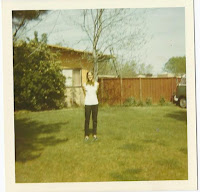When I first scanned the list of topics for my monthly
Brides blog post, the only thing I zeroed in on for June was that the topic
could be whatever the author wanted to blog about. It wasn’t until after I
wrote my piece and checked the topic again that I realized I was supposed to
share some of my favorite memories! Sorry about that, but I’m
sticking with my original post on gardening. *wink*
Anyway, I’m going to share the things I’ve learned over
the years:
A garden is a never ending project. You can’t finish it
in one season. Tackle it bed by bed. Then you can go back to the earlier beds and
do them over, particularly as your gardening savvy improves. And so on and so
on. See what I mean? Never ending. Kind of like infinity.
This is a big one – Find the plants that like the spot
you have!! Or, do not try and force a round
peg into a square hole. A fern will not survive in a hot, dry sunny spot, no
matter how much you baby it. Sun loving annuals will not thrive in the shade
regardless of how much water and fertilizer you give them. So, don’t be afraid
to try something – if it fails, try again. If it grows, jackpot! This is a
picture of my side yard which is mostly dappled shade. I’ve always wanted a
hydrangea so I’ve planted that this year (it's the little shrub with purple flowers over by the fence) and I will wait with bated breath to see
if it reappears in the spring. The hostas were also an experiment and
obviously, I got that right. (Below, lining the walkway.)
Birds like water. Hares too, apparently. Anyway, a bird bath is just as good for attracting birds as a feeder. Plus a lot less messy.
Try native plants. If they can grow without your help,
imagine what a little water and TLC will do for them. This is a patch of Snowberry in our back yard. I’ve never seen it grow taller than knee height in
the wild but in my back yard it makes me look like a gardening super star!
 Gardening can be a challenge here in the Chinook belt of
Alberta, so I plant all my annuals in pots. At the first sign of early frost,
late frost and that scourge of the prairies, hail, I move the pots into
shelter. That way I can participate in Calgary’s favorite summer pastime – The Running
of the Pots.
Gardening can be a challenge here in the Chinook belt of
Alberta, so I plant all my annuals in pots. At the first sign of early frost,
late frost and that scourge of the prairies, hail, I move the pots into
shelter. That way I can participate in Calgary’s favorite summer pastime – The Running
of the Pots.
Mulch is your friend. Nothing smartens up an untidy bed
more than a layer of gravel, or bark chips, or whatever snags your fancy. The
odd garden ornament here and there is pretty cute too.
Enjoy all the seasons. Spring is great for the planning
and anticipation, for those first few days outside after a long winter, for hauling
out the shovels and ending up with dirt under your finger nails. Summer is when
your dreams and plans start to take root (ha, no pun intended) and the display of
flowers and foliage ramps up. Autumn is lovely for the colors and crisp air and
the final clean up, and jotting down notes and ideas for next year. And winter for the respite.
Good for both your garden and you and we won’t even discuss shoveling snow.
Which is also good for you, by the way, as long as you don’t overdo it.
Finally, most important, make sure to regularly take the
time to enjoy the fruits of your labor! And remember, a bad day in the garden
is better than a good day at work. Oh wait, there is no bad day in the garden!




















